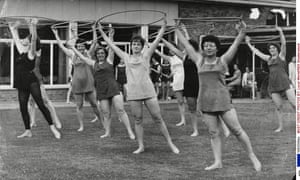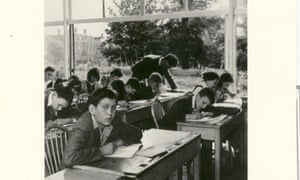Bauhaus and moral purpose: the very model of modern community schools
The village colleges of Cambridgeshire, pioneering as comprehensives in the 1930s, are still setting an example in 2015
This autumn Impington Village College, in the rapidly growing commuter belt around Cambridge, has had a bit of a moment. The comprehensive academy – my old school – has seen the culmination of a two-year celebration set up to mark its 75th anniversary, and it’s been bursting with activity – holding lectures, symposia and workshops.
Arranging chairs and organising photographs at the school on an autumn morning is Elena Cologni, artist in residence at the school. “Impington has such a rich story: the social history, the architectural history,” she says. “It’s of international relevance.” And yes, it is – although as an undistinguished Impington alumnus from the 1970s, I didn’t appreciate it at the time.
Still, I knew that Impington had two key claims to fame. The first was that it was one of a pioneering group of rural schools in South Cambridgeshire called the village colleges, also including Sawston, Bottisham, Linton and Bassingbourn – with others (including Soham and Comberton) arriving later in similar spirit. Set up by pioneering educationalist Henry Morris, chief education officer for Cambridgeshire, the village colleges became a national model for a kind of community-based comprehensive, before the Butler Act came along.
The school is also an architectural setpiece. Designed by Bauhaus founder Walter Gropius with British architect Maxwell Fry in 1939, it is an exemplar of humanist modernism: an essay in genteel grandeur, with barely perceptible curves, local yellow bricks, ribbon windows and a fan-shaped hall that influenced London’s Royal Festival Hall. In 1971 it became Grade 1 listed, reflecting the importance of Gropius’s only British project. The Observer’s architecture critic Rowan Moore called it one of the 10 best schools in the country.
The principal today, Robert Campbell, says the building still works. “It’s not quaint or delicate. The central long promenade is light and inviting. You never feel hemmed in.” With glazed external walls and green swards between single-storey classrooms, there’s an early sense of the open-plan schools of the future. One problem – fossilised by the Grade 1 listing – is that single-paned windows are cold. I can testify to that.
The first village college was Sawston, south of Cambridge, built in 1930. This was, as Campbell says, “14 years ahead of the 1944 Education Act, which ushered in comprehensive education”. Morris’s vision was also ahead of the London County Council’s decision to go comprehensive in 1936, and postwar, Impington appeared as if fully formed – although it remained streamed until the 1980s.
The village colleges are now largely in multi-academy trusts, and still take their links with other schools and their local communities very seriously.
Impington’s beginnings were helped by the local jam factory, Chivers, whose head, John Chivers, specified Gropius as designer. Other innovative ideas manifested in village colleges, one being that they would revivify rural communities in the context of prewar rural decline, and also that school should be central to local life and open to all ages.
“Morris’s vision was utterly inspiring and unique,” says Campbell, citing a continuing educational culture of “knowledge exchange”, rather than the Jesuitical “give me the seed and we’ll make the bread” ethos of his own schooldays. Impington’s motto is “Let knowledge grow”. Morris believed that education shouldn’t just be the “dissemination of knowledge, but an induction into a way of life”, and as Andrew Saint, in his book Towards a Social Architecture: The Role of School Building in Post-War England, wrote: “Henry Morris’s celebrated series of village colleges in Cambridgeshire were the most prophetic expression of what a ‘community school’ might mean … an educational example [and] … an architectural one as well.” Thus the village colleges anticipated the postwar school building boom, and many of the values enshrined within it.
There was always a slightly progressive whiff at Impington. Gropius had met Leonard Elmhirst, of the progressive school Dartington Hall, in 1934 and Morris’s values were liberal, if a touch paternalistic. But his idea of the school as a place where “life is lived”, at the centre of each village, rings true here today. “It brought into school the other educational institution – the family – and was a pioneer of lifelong learning,” says Campbell. “Now, children from poorer areas of north Cambridge – Arbury, King’s Hedges – are provided a historic environment alongside the children of Cambridge University fellows.” And there is still a strong adult learning programme at Impington.
A feature of the school in my day was our head, the poet John Brackenbury, a Quaker who in the presence of bad behaviour would invite malefactors to his office and steeple his fingers in quiet contemplation. The jury was out as to the efficacy of this approach, but Campbell approves of Brackenbury for maintaining a “non-conformist, anti-authoritarian, accessible and questioning tradition”. It still influences practice, he says. “Student councils aren’t elected. Anyone can attend. And it’s important that Impington has moral purpose. We haven’t had an expulsion for seven years, and we take children with special educational needs and achieve positive outcomes.”
The values, says Campbell, “go up against the performance and measurement ethos predominant in education.” While some of Morris’s rhetoric seems a touch archaic, his brickbats against an education that is “merely utilitarian” chimes in our times of mass measurement. Campbell has tried to keep Impington’s pioneering spirit alive. It was one of the first two schools to offer the international baccalaureate, and is ready to implement other innovations in behaviour improvement and vertical tutoring (mixing age groups).
Could Morris’s village colleges once again become a signpost in our regulated era? In his new book, Our Kids, the US political scientist Robert Putnam advances the idea that the community school model (pioneered by philosopher John Dewey in the US) could help to heal inequality as “community schools include youth activity at all hours and programmes to engage parents and community members actively in the educational process”.
In Britain, where inequality is widening, perhaps the Morris agenda has become more urgent. In the past five years, the academy chains that have proliferated seem to many to be like corporate structures, less focused on the communities they serve.
Sir Cyril Taylor, an early architect of the academies programme, feels strongly that schools should once again aspire to become centres of their communities, offering all kinds of education, at all times. “As a social entrepreneur myself, it’s obvious,” he says. “Skills should be taught to address aspects like the shortage of IT workers and, if possible, schools should be open from morning till evening.”
And with Burntwood school’s recent Stirling prize win bringing school architecture back into focus, perhaps my alma mater’s marriage of architecture and educational innovation is worth another look.



沒有留言:
張貼留言